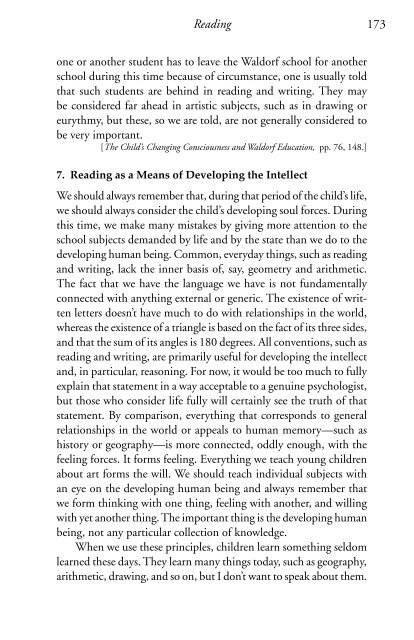Teaching Language arTs in The WaLdorf schooL
Teaching Language arTs in The WaLdorf schooL
Teaching Language arTs in The WaLdorf schooL
You also want an ePaper? Increase the reach of your titles
YUMPU automatically turns print PDFs into web optimized ePapers that Google loves.
Read<strong>in</strong>g<br />
173<br />
one or another student has to leave the Waldorf school for another<br />
school dur<strong>in</strong>g this time because of circumstance, one is usually told<br />
that such students are beh<strong>in</strong>d <strong>in</strong> read<strong>in</strong>g and writ<strong>in</strong>g. <strong>The</strong>y may<br />
be considered far ahead <strong>in</strong> artistic subjects, such as <strong>in</strong> draw<strong>in</strong>g or<br />
eurythmy, but these, so we are told, are not generally considered to<br />
be very important.<br />
[<strong>The</strong> Child’s Chang<strong>in</strong>g Consciousness and Waldorf Education, pp. 76, 148.]<br />
7. Read<strong>in</strong>g as a Means of Develop<strong>in</strong>g the Intellect<br />
We should always remember that, dur<strong>in</strong>g that period of the child’s life,<br />
we should always consider the child’s develop<strong>in</strong>g soul forces. Dur<strong>in</strong>g<br />
this time, we make many mistakes by giv<strong>in</strong>g more attention to the<br />
school subjects demanded by life and by the state than we do to the<br />
develop<strong>in</strong>g human be<strong>in</strong>g. Common, everyday th<strong>in</strong>gs, such as read<strong>in</strong>g<br />
and writ<strong>in</strong>g, lack the <strong>in</strong>ner basis of, say, geometry and arithmetic.<br />
<strong>The</strong> fact that we have the language we have is not fundamentally<br />
connected with anyth<strong>in</strong>g external or generic. <strong>The</strong> existence of written<br />
letters doesn’t have much to do with relationships <strong>in</strong> the world,<br />
whereas the existence of a triangle is based on the fact of its three sides,<br />
and that the sum of its angles is 180 degrees. All conventions, such as<br />
read<strong>in</strong>g and writ<strong>in</strong>g, are primarily useful for develop<strong>in</strong>g the <strong>in</strong>tellect<br />
and, <strong>in</strong> particular, reason<strong>in</strong>g. For now, it would be too much to fully<br />
expla<strong>in</strong> that statement <strong>in</strong> a way acceptable to a genu<strong>in</strong>e psychologist,<br />
but those who consider life fully will certa<strong>in</strong>ly see the truth of that<br />
statement. By comparison, everyth<strong>in</strong>g that corresponds to general<br />
relationships <strong>in</strong> the world or appeals to human memory—such as<br />
history or geography—is more connected, oddly enough, with the<br />
feel<strong>in</strong>g forces. It forms feel<strong>in</strong>g. Everyth<strong>in</strong>g we teach young children<br />
about art forms the will. We should teach <strong>in</strong>dividual subjects with<br />
an eye on the develop<strong>in</strong>g human be<strong>in</strong>g and always remember that<br />
we form th<strong>in</strong>k<strong>in</strong>g with one th<strong>in</strong>g, feel<strong>in</strong>g with another, and will<strong>in</strong>g<br />
with yet another th<strong>in</strong>g. <strong>The</strong> important th<strong>in</strong>g is the develop<strong>in</strong>g human<br />
be<strong>in</strong>g, not any particular collection of knowledge.<br />
When we use these pr<strong>in</strong>ciples, children learn someth<strong>in</strong>g seldom<br />
learned these days. <strong>The</strong>y learn many th<strong>in</strong>gs today, such as geography,<br />
arithmetic, draw<strong>in</strong>g, and so on, but I don’t want to speak about them.

















